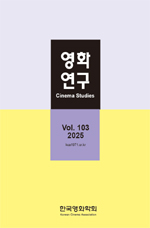- 영문명
- The Perspective of a Hyperobject, Overview Image: Focusing on (Post-)Apocalyptic Genre Films
- 발행기관
- 한국영화학회
- 저자명
- 김선아(Sunah Kim)
- 간행물 정보
- 『영화연구』제103호, 99~125쪽, 전체 27쪽
- 주제분류
- 예술체육 > 예술일반
- 파일형태
- 발행일자
- 2025.03.23
6,040원
구매일시로부터 72시간 이내에 다운로드 가능합니다.
이 학술논문 정보는 (주)교보문고와 각 발행기관 사이에 저작물 이용 계약이 체결된 것으로, 교보문고를 통해 제공되고 있습니다.

국문 초록
본 논문은 인류세 시대 (포스트) 아포칼립스 장르 영화를 하이퍼객체(hyperobject) 개념을 통해 분류하고, 장르의 의의를 논한다. 아포칼립스는 신적 계시를 통해 세계의종말과 열린 세상을 의미하지만 현대에 와서는 기후변화, 자본주의적 초국가적 시스템과 같은 비가시적이며 총체화가 불가능한 구조로 세속화되었다. 이러한 ‘지속적 종말’의 감각은 대중문화, 특히 영화에서 강하게 재현되며, 하이퍼객체에 대한 영화적감각으로 표현된다.
티모시 모턴이 정의한 하이퍼객체는 인간보다 더 크고 시공간적으로 광범위하여 인간의 지각과 통제를 초월하는 존재들이다. 이러한 개념을 바탕으로 (포스트) 아포칼립스 영화는 크게 세 가지 유형으로 나눌 수 있다. 첫째, <투모로우>(2004) 같이 인간 영웅이 대재앙을 극복하는 인간 중심적이니 재난 스펙터클, 둘째, <설국열차> (2013)처럼 거대한 자본주의적 질서를 형상화하여 복잡한 초국가적 시스템을 단순한 환원 구조로 재현하는 방식이다. 마지막으로, <놉>(2022)처럼 전통적인 아포칼립스 서사를 벗어나 종말이 미래의 특정 사건이 아니라 현재에 이미 내재한 상태임을 보여주는 유형이 있다. 본 논문은 세 번째 유형의 영화에 집중한다.
(포스트) 아포칼립스 장르영화는 ‘오버뷰 이미지(overview image)’ 개념과도 연관된다. 과거 신의 자리가 있던 하늘은 현대 기술을 통해 감시 위성이 떠 있는 공간으로 변했다. 인간은 하늘을 장악한 듯하지만, 역설적으로 이는 인간의 시야를 넘어선 존재들의 등장과 맞물린다. <놉>에서 등장하는 ‘움직이지 않는 구름’은 기존의 오버뷰 이미지가 제공하는 통제의 감각을 깨뜨리고, 인간이 알 수 없는 혹은 부분적으로만 감각할 수 있는 하이퍼객체의 존재를 암시한다. 이러한 감각은 단순한 재난 서사를 넘어, 인간이 세계를 이해하고자 하는 방식 자체를 뒤흔든다. 특히 <놉>은 인간의 시야 바깥에 있는 존재를 통해, 종말이 미래에 일어나는 사건이 아니라 지금 이 순간 이미 진행 중임을 감각적으로 일깨운다. <놉>은 하이퍼객체의 존재를 통해 신적 시점을 세속화한 인간 중심주의를 해체하면서 새로운 정동적이고 철학적인 사유를 요구한다.
영문 초록
This paper categorizes (post-)apocalyptic films of the Anthropocene era through the concept of the hyperobject and discusses the significance of the genre. Traditionally, the apocalypse signifies both the end of the world and the revelation of an open world through divine intervention. However, in the modern era, it has been secularized into invisible and untotalizable structures such as climate change and the capitalist transnational system. This sense of “perpetual apocalypse” is vividly represented in popular culture, particularly in cinema, as an aesthetic manifestation of hyperobjects.
The hyperobject, as defined by Timothy Morton, refers to entities that are vastly larger than humans and that extend across space and time, transcending human perception and control. Based on this concept, (post-)apocalyptic films can be broadly classified into three types. The first type consists of anthropocentric disaster spectacles, such as The Day After Tomorrow (2004), in which human heroes overcome catastrophic events. The second type includes films like Snowpiercer (2013), which visualize immense capitalist structures, reducing complex transnational systems into simplified, allegorical representations. The third type, exemplified by Nope (2022), departs from the traditional apocalyptic narrative, illustrating that the apocalypse is not a future event but a condition already embedded in the present. This paper focuses on the third category.
(Post-)apocalyptic films are also closely related to the concept of the “overviewimage.” In the past, the heavens were conceived as the domain of divine perspective, but in the modern era, they have become a space occupied by surveillance satellites. While humans seem to have taken control of the skies, paradoxically, this shift coincides with the emergence of entities beyond human perception. In Nope, the “motionless cloud” subverts the sense of control provided by the traditional overview image, hinting at the presence of hyperobjects that humans can only partially perceive. This aesthetic sensibility disrupts conventional disaster narratives, fundamentally challenging the ways in which humans seek to understand the world.
Particularly, Nope uses an entity beyond human sight to evoke an awareness that the apocalypse is not an impending future event but an ongoing phenomenon in the present. By foregrounding the presence of hyperobjects, the film dismantles the human-centered perspective that has secularized the divine viewpoint, demanding a new affective and philosophical engagement with the world
목차
1. 서론: 인류세의 아포칼립스
2. 하이퍼객체와 (포스트) 아포칼립스 장르 영화의 세 가지 분류
3. 오버뷰 이미지: 신의 시점의 세속화
4. 종말이 드리운 맑은 하늘 - <놉>의 움직이지 않는 구름
5. 결론
키워드
해당간행물 수록 논문
- 영화 리터러시의 재매개를 위한 논의: 시네필리아에서 페다고지로의 전환, ‘관객 개발’
- 한국 초능력 영화의 생명정치: <마녀>를 중심으로
- 한국 재난영화의 장르 관습과 사회정치학 2009∼2016
- 메타버스의 리좀적 공간성과 그 의미: <레디 플레이어 원>(2018)
- OTT 영화의 기획 전략과 서사 구조 변화 연구 : <사냥의 시간>, <승리호>, <연애 빠진 로맨스>와 오리지널 기획 영화 <전, 란> 넷플릭스 배급 사례 분석을 중심으로
- 장르영화로서의 주선율: 내러티브 체계를 중심으로
- 다큐멘터리영화의 극영화 스타일 연구: <거미의 땅>을 중심으로
-
다큐멘터리에서의 AI 사용이 던지는 문제와 가능성: IDFA 개막작
(2024)를 중심으로 - 영화 속 장소를 통해 본 1990년대 중국 청년의 표상: <천과월량적여행(穿过月亮的旅行)>(2024)을 중심으로
- 체계적 문헌고찰을 통한 영화 제작단계의 탄소배출에 대한 해외연구 동향 및 고찰
- 하이퍼객체의 시점, 오버뷰 이미지: (포스트) 아포칼립스 장르 영화를 중심으로
- 한국형 오컬트 영화의 장르 융합 양상 연구: <곡성>과 <파묘>를 중심으로
- 영화 <콘크리트 유토피아>에서 나타나는 폭력에 대한 고찰: 르네 지라르의 욕망 이론과 희생양 메커니즘을 중심으로
- 중국 개혁개방 시기 일본영화의 문화적 수용
- 예술영화를 통해 본 김정은시대 북한 영화의 변화 양상
- <플란다스의 개>(2000)에 나타난 자기반영성과 봉준호의 영화적 자의식:‘구라풀기(Fabulieren)’와 ‘슬랩스틱(slabstick)’을 중심으로
참고문헌
관련논문
예술체육 > 예술일반분야 BEST
- 생성형 AI 도구와 디자이너의 협업 프로세스 개발 - 이미지를 통한 아이디어 확산에서 고해상도 렌더링까지
- ‘일과 삶의 균형(Work-Life Balance)’ 척도 개발을 위한 연구
- 디자인 전공 교과목에서의 생성형 AI 도구 활용 사례 연구
예술체육 > 예술일반분야 NEW
더보기최근 이용한 논문
교보eBook 첫 방문을 환영 합니다!

신규가입 혜택 지급이 완료 되었습니다.
바로 사용 가능한 교보e캐시 1,000원 (유효기간 7일)
지금 바로 교보eBook의 다양한 콘텐츠를 이용해 보세요!



